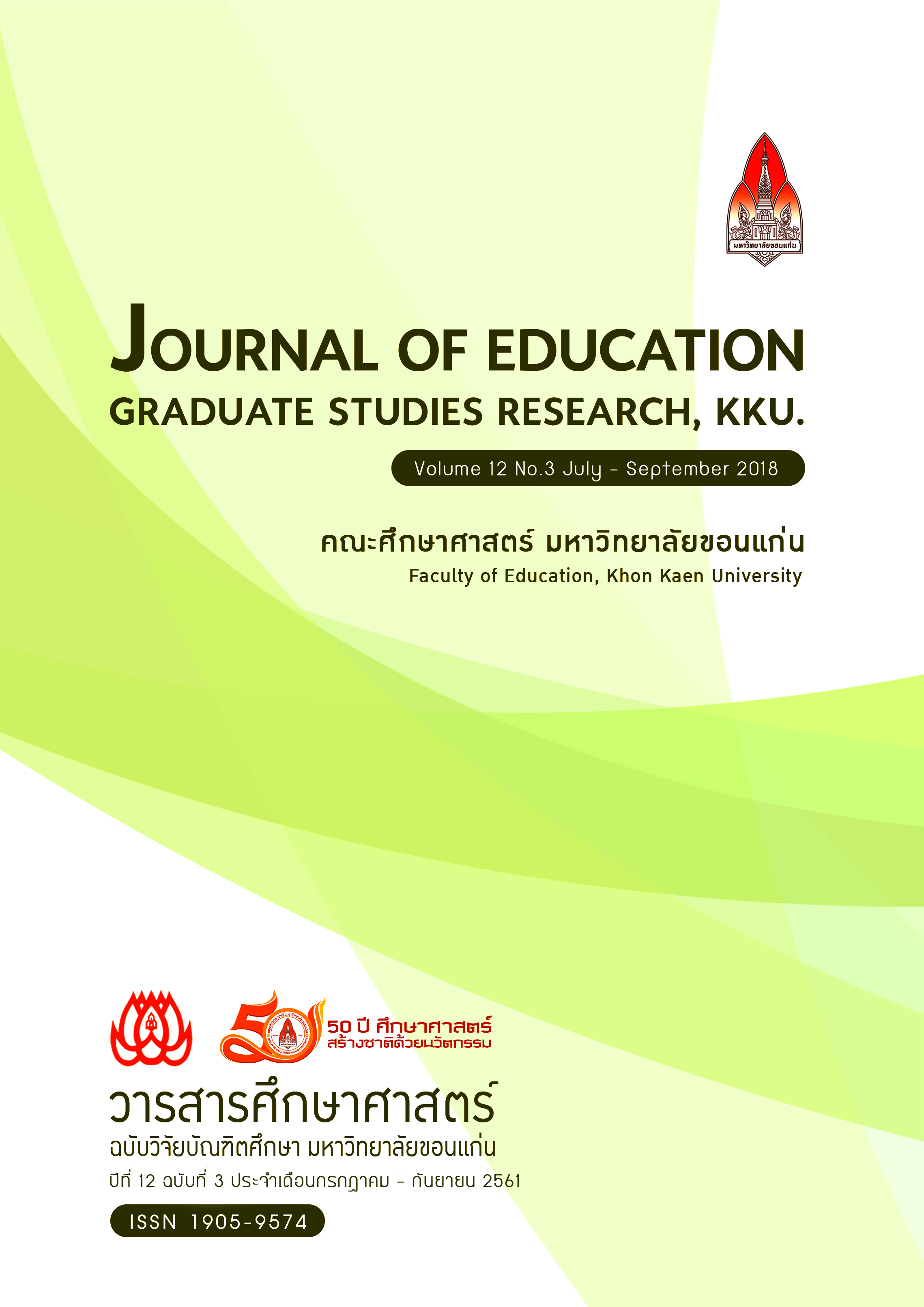The Multi-Level Factors Affecting Teachers’ Teaching Effectiveness in School under the Office of Secondary Educational Service Area 25
Main Article Content
Abstract
The purpose of this research were 1) to study the level of teachers’ teaching effectiveness, 2) examine the level of school factors and classroom factors affecting teachers’ teaching effectiveness, and 3) to investigate the effect of schools’ factors level and classrooms’ factors level to teachers’ teaching effectiveness in school under the Office of Secondary Educational Service Area 25. The population in this study included the administrators and teachers and teaching staff in school under the Office of Secondary Educational Service Area 25. A total of 513 samples consisted of 68 school administrators at the macro level and 445 teachers and teaching staff at the micro level. The samples were 20:1 stand for twenty samples for the observed variable (Hair, et al, 2010). This study utilized the quantitative descriptive research using two types of questionnaires. The hierarchical linear model (HLM) analysis was utilized to test the fixed effect and random effect of the null model, simple model and hypothesis model. The findings showed that: 1) overall aspects of teachers’ teaching effectiveness indicated at a moderate level. Considering each aspect, the average ordering from high to low it found that teachers’ satisfaction towards working, participation of parent and community were at a high level and learning achievement was at low level. 2) overall factors affecting teachers’ teaching effectiveness at macro level indicated at a highest level. Considering each aspect, the average ordering from high to low it found that academic leadership, school culture were at a highest level, and school environment was at high level. Overall factors affecting teachers’ teaching effectiveness at micro level also indicated at a high level. Considering each aspect, the average ordering from high to low it found that learning and teaching environment, teachers’ behaviors, and social support for teachers. 3) Variable at macro level, non factors contributed to teachers’ teaching effectiveness with a statistical significance. In which the macro level variables was able explain the variation of teachers’ teaching effectiveness for 37.50 percent. Micro level variables contributed positively to teachers’ teaching effectiveness at the statistical significance level of .01 including social support for teachers (β = 0.333, t = 11.770, Sig.<0.001), teachers’ behaviors (β = 0.113, t = 3.234, Sig. = 0.001), and learning and teaching environment (β = 0.171, t = 5.064, Sig.< 0.001) in which the micro level variables could explain the variation of teachers’ teaching effectiveness for 52.62 percent
Article Details
References
บุญใจ ศรีสถิตนรากูร. (2547). ระเบียบวิธีการวิจัยทางการพยาบาลศาสตร์. พิมพ์ครั้งที่ 3. กรุงเทพฯ: ยูแอน์ไอ พริ้นติ้งมีเดีย.
Driver, R., Newton, P., & Osborne, J. (2000). Establishing the norms of scientific argumentation in classrooms. Science Education, 84(3), 287-313.
Erduran, S., Ardac, D., & Yakmaci-Guzel, B. (2006). Learning to teach argumentation: case studies of pre-service secondary science teachers. Eurasia Journal of Mathematics, Science and Technology Education, 2(2), 1-14.
Kemmis, S., & McTaggart, R. (1990). The action research planner. 3rd ed. Melbourne: Deakin University
Press.
Kuhn, L., Reiser, B. J. (2006). Structuring activities to foster argumentative discourse. Paper presented at the American Educational Research Association, San Francisco, CA.
Kuhn, D. (2010). Teaching and Learning Science as Argument. Science Education, 94(2), 810-824.
National Research Council. (2013). A framework for K-12 science education: Practices, crosscutting concepts, and core ideas. Washington, DC: National Academies Press.
Osborne, J., & Patterson, A. (2012). Scientific argument and explanation: A Necessary distinction? Science Education, 95(4), 627-638.
Osborne, J., & Chin, C. (2010). Students’ Questions and Discursive Interaction: Their Impact on Argumentation During Collaborative Group Discussions in Science. Journal of Research in Science Teaching, 47(7), 883-908.
Richey, R. C., & Klein, J. D. (2007). Design and Development research. Mahwah, NJ: Lawrence Erlbaum Associates.
Sadler, T. (2006). Promoting discourse and argumentation in science teacher education. Journal of Science Teacher Education, 17(3), 323-346.
Sampson, V., and Blanchard, M. (2012). Science Teachers and scientific argumentation: Trends in practice and views. Journal of Research in Science Teaching. 49(9), 1122-1148.
Sampson, V. (2009). Science teachers and scientific argumentation: Trends in practice and beliefs. Paper resented at the Annual Conference of the National Association of Research in Science Teaching (NARST). Retrieved. Simon, S. (2011). Argument. In How Science Works: Exploring Effective Pedagogy and Practice. Edited by Toplis, Rob. New York, USA: Routledge.
Simon, S., Erduran, S., & Osborne, J. (2006). Learning to teach argumentation: Research and development n the science classroom. International Journal of Science Education, 28(2/3), 235-260.
Wellington, J. & Ireson, G. (2012). Science Learning, Science Teaching. 3rd ed. New York, USA: Routledge.
Zeidler, D. L. et al. (2003). The Role of Argument During Discourse About Socioscientific Issues. Edited by Zeidler, Dana L. V. 19. pp. 97-116. Springer Netherlands.

